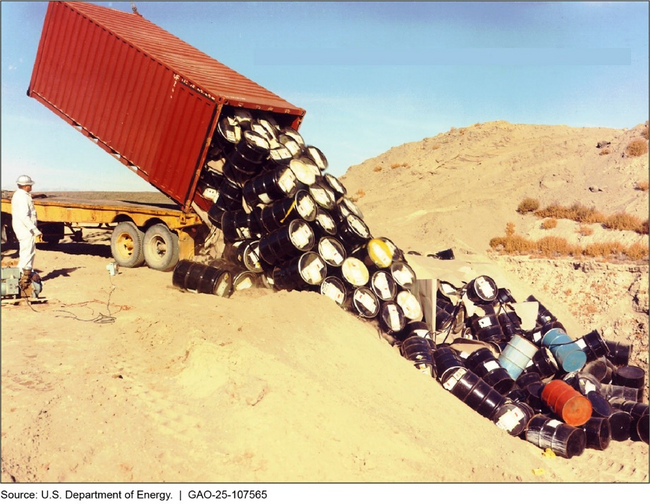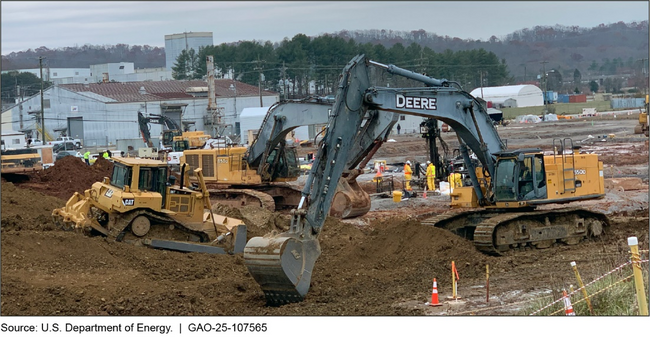Nuclear Waste Cleanup: DOE Should Collect Information Specific to Soil and Legacy Landfills to Inform Overall Remediation Efforts
Fast Facts
The Department of Energy manages the cleanup of soil and landfills contaminated with nuclear waste left over from decades of nuclear weapons production.
We spoke with officials at 8 nuclear cleanup sites to learn about the status of these efforts. They told us that the remaining soil and legacy landfill cleanup will cost about $15 billion over the next 6 decades. But DOE headquarters didn't have specific information on hand about the cleanup activities at each site. Headquarters could use this information to better prioritize cleanup projects across sites for making budget decisions.
We recommended DOE gather this information from sites.
Waste from the Idaho National Laboratory Being Disposed of in a Landfill in the 1960s

Highlights
What GAO Found
The U.S. Department of Energy’s Office of Environmental Management (EM) is responsible for cleaning up contaminated soil and legacy landfills resulting from Manhattan Project-era and Cold War-era waste disposal at 12 of its 15 sites. GAO examined eight sites with such contamination and found that site-specific factors inform cleanup decisions in the context of federal and state laws and regulations, as well as agreements EM follows to conduct cleanup. These factors include future land use, physical parameters, and community acceptance.
For the eight sites GAO examined, soil and legacy landfill cleanup is estimated to cost approximately $15 billion over the next 6 decades. However, the sites’ estimated scope, schedule, and cost for cleanup may change as more information becomes available. In particular, at two of the sites, EM and regulators have worked for more than a decade on the scope of remedial actions needed to clean up contaminated soil and legacy landfills. The final remedy decisions will affect the sites’ cost estimates. For example, cleanup of one legacy landfill at an EM site in Los Alamos, New Mexico, could cost about $12 million under one potential remedy but about $805 million if another remedy is selected.
Removal of Contaminated Soil at Oak Ridge Office of Environmental Management

EM headquarters is unable to readily identify the scope, schedule, and cost of soil and legacy landfill cleanup over the 12 sites. While EM sites have information on soil and legacy landfill cleanup, sites report data to EM in an aggregated form, with soil cleanup information combined with those of other activities, such as groundwater cleanup. EM’s 2020 Program Management Protocol states that headquarters provides technical and policy support in the planning and field execution of soil and other cleanup. With distinct information on soil cleanup activities, EM headquarters could better provide technical support for planning. In addition, as remedy decisions are made, having information available that is specific to soil and legacy landfill cleanup at EM sites would improve headquarters’ ability to track resources needed to implement remedy decisions and their schedule and cost implications on the entire EM program.
Why GAO Did This Study
EM is responsible for addressing hazardous and radioactive waste from nuclear weapons production and energy research at DOE sites. Contaminated soil at these sites poses a threat to public health and the environment, making soil and legacy landfill cleanup critical to EM’s mission.
GAO was asked to review EM’s soil and legacy landfill cleanup efforts. This report examines (1) the regulatory framework for soil and legacy landfill cleanup at selected EM sites and how site-specific factors inform remedy decisions and (2) available data on the scope, schedule, and cost for soil and legacy landfill cleanup.
GAO examined eight sites selected to include various regulatory frameworks governing EM’s cleanup, different stages of cleanup, remaining remediation decisions, and various end uses for the land. GAO conducted site visits at three of these sites. GAO examined relevant laws and regulations and reviewed agency documents on soil and legacy landfill cleanup. GAO interviewed officials from EM, the U.S. Environmental Protection Agency, and state regulatory agencies.
Recommendations
GAO recommends that EM headquarters collect information specific to the scope, schedule, and cost of soil and legacy landfill cleanup and use it to enhance technical and policy support provided to sites and inform prioritization decisions to reduce risk. EM neither agreed nor disagreed with the recommendation and deferred its response regarding implementation to a later date.
Recommendations for Executive Action
| Agency Affected | Recommendation | Status |
|---|---|---|
| Office of Environmental Management | The Assistant Secretary for the Office of Environmental Management should ensure that EM headquarters collects and uses information specific to the scope, schedule, and cost of soil and legacy landfill cleanup to enhance technical and policy support provided to sites and inform prioritization decisions to reduce risk. (Recommendation 1) |
When we confirm what actions the agency has taken in response to this recommendation, we will provide updated information.
|
